Introduction by Lucinda Lourie and Miriam Wilkins
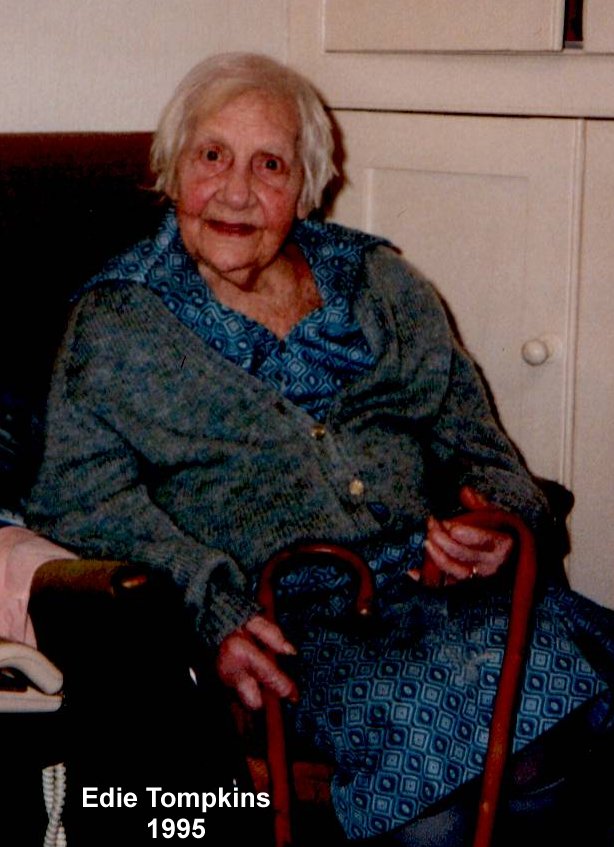
We first met Edith Tompkins in September 1994, at the suggestion of Rev. Cavell Northam. He knew that we were interested in putting together people’s recollections of Calverton, and knew that she had spent most of her young life in Calverton.
We visited her on four occasions at her home for 61 years at 56 Calverton Road Stony Stratford. At the age of 91, although she was very deaf, she was still full of life and mischievous humour. Her memories of Calverton probably went back further than any other person living at that time.
We did not use a tape recorder in these conversations, doing our best to jot down her reminiscences over a cup of tea. Often it was difficult to follow the intricacies of village life and families.
Sometimes she could not remember exactly how it was herself.
On one occasion we took her out to tea with George and Ivy Cowley. As we drove through the Wealds on our way to Upper Weald Edie was very distressed at the state of the hedgerows, so overgrown. When she lived in the village there had been a man who did all the hedging and ditching, and kept the place tidy.
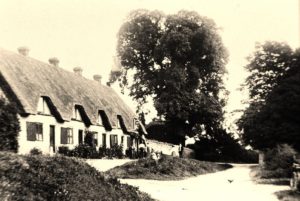
On 16 October 1994 when we visited Edie, she was very excited as a book called “Around Stony Stratford” had just been published and Edie had helped the author, Audrey Lambert, to identify some of the people in an old photograph of Manor Farm Cottages, taken about 1910.
One was Mrs Godfrey, standing in the doorway, and she lived near Winslow. where Edie used to visit her. She always gave Edie a tin of biscuits and a mug of cow’s milk.
Sitting on the bank are Edie herself and Eunice Petty. They were great friends but used to “fight and kick a lot, then kiss and make up.”
Eunice left Calverton with her family, to go and live on a tea plantation in Africa, when Edie was about 8 years old. Edie remembers weeping on the doorstep, and her mother chiding her and saying she would get a cold bottom.
On 12 March 1994 Edie joined other old Calverton friends at the “Map & Bottle” lunch; one of the first village get-togethers, that later formed itself into the Calverton Records Project.
‘Edie’ Tompkins was born in 1903, probably, she thought, while her mother was staying with cousins at Skirmett, near Henley-on-Thames. She was the youngest of 7 children, 4 brothers and 2 sisters, and was named Edith after Rev. Willis’s daughter, who was a nun. Edie did not think much of this.
Both parents came from Thornborough, where her father, called Miller, worked as a gardener at Thornton Hall, until it became a convent.
The necessity of finding a cottage attached to the job led the family to move to Manor Farm Calverton, where her father worked for the tenant farmer, by the name of Reed. They lived in one of the Manor Farm Cottages. There were 5 houses then called the Five Hausen and they lived in the end one nearest the Church.
Her mother was a very strong character, and Edie describes her as having,” a nose like the gates of heaven without the music inside”. Her father was a genius at growing violets, so much so, that when Richard Fountaine’s aunt, Lydia, got married, he grew violets specially for her wedding, although it was in September.
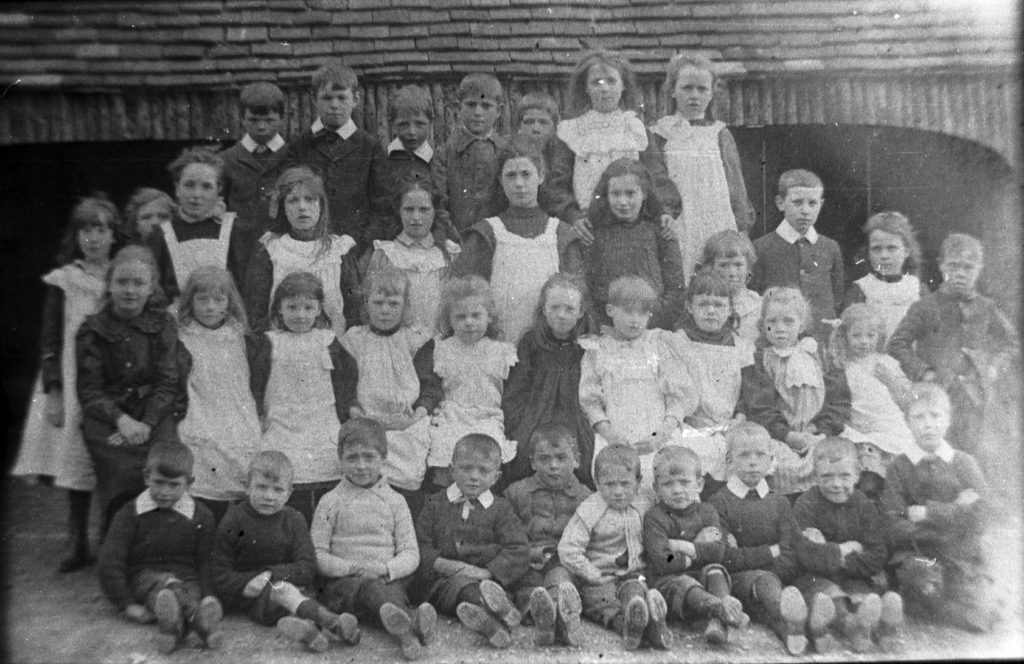
Edie went first to Calverton village school. At school she shared a desk with Clara Clark and Ivy West (Cecil West’s sister). See also Recollections of Calverton from the Diary of Laura Anne Clark.
At 11 years she left school, and went to London to learn to be a nanny. She was only there for four months; her mother missed her youngest child and telephoned her to come home. Her father picked her up from Wolverton station in a horse and cart, and when they reached Crosshills she asked him to stop “because it was so beautiful”, she said.
After that she “played at factories” at McCorquodales in Wolverton.
Her husband, Eric Tompkins, was born in Stony Stratford. He worked for his Uncle Arthur, the Postmaster there, and was sent delivering telegrams on his bike. He fought in the First World War, where he experienced being gassed.
Eric and his mother moved to 56 Calverton Road in 1929, when the house had just been built. It overlooked the River Ouse and Passenham meadows, and at the end of the garden there was a cow shed and milking parlour. During the war Edie was illegally given extra milk by the cowman, which she turned into butter by shaking it in a bottle.
Family Life and a New House
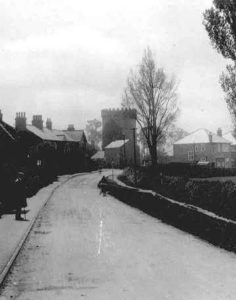
Where the junction of Calverton and Augustus Road is now, there used to be a 60ft water tower, and beyond that were fields and barns where tramps used to sleep.
Edie met Eric at a cricket match on Crow’s Piece, Lower Weald, George Cowley’s field.
They got married in 1933, at Calverton church at 8am. “No fuss and ooh la la”. She wore a navy suit and hat and a very nice blouse from Adnets, Northampton (“oh la la where the posh people went”). She moved to No. 56 opposite where the old water tower stood and where she remained for 61 years until her death.
Eric bought an apprenticeship to the Wolverton Works; though this was free to the sons of workers there. He used to catch the tram to work up until 1926 when it closed at the start of the General Strike. Edie continued to work at McCorquodales and used to bicycle to work.
They never had children of their own; Eric had had measles badly as a child, Edie explained. She said it was just as well as she would have been as “soft as tripe” with them. However, her great-nephew, Brian, became like a son to them.
Her mother was 43 when Edie was born, so Edie’s niece, May, was only 6 years younger than her. During the War, when May was working for the Red Cross in High Wycombe, it was Edie who looked after May’s son Brian.
Brian used to go up to Manor Farm and lend a hand, and one day came back with 7 shillings. It was payday, and he had joined the other farm labourers queueing up for their money at George Fountaine’s kitchen table.
Sadly Brian died while only in his 40s.
Edie’s Memories of Calverton
The Village pond Incident
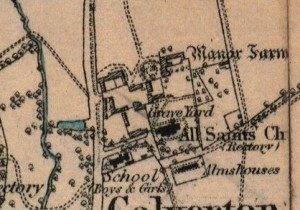
One of Edie’s earliest memories was waking at 5 o’clock one morning, in Manor Farm Cottages, to a great “hullabaloo”, down by the Village Pond opposite. Looking out of the bedroom window she saw that a carthorse had become bogged down in the Pond, and men were using ropes, and a team of horses to pull it out. She remembers her mother nagging her to put her coat on as she looked through the open window.
She said that they did rescue the poor animal, but it was a sorry sight, exhausted and covered with mud. The men threw water from the brook over it to clean it before they led it away but “They didn’t leave a note to say why they were there”.
The Pond was eventually filled in with village rubbish and ashes (there was no rubbish collection in those days). “Filled with mysteries” were Edie’s dark words! (It was partly due to this prophesy that it was decided to excavate the pond to see just what was in there. See report on the village pond dig)
Clara Clark’s Mother’s Books
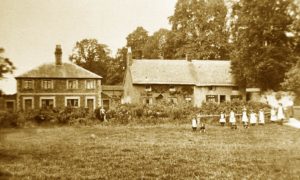
Clara was a great friend of Edie’s, but nearly got her expelled from school.
Edie remembers how one day when she was threading beechnuts with some village children in the field opposite Manor Farm, Clara brought some of her mother’s books to show them. (The field is called The Meadow but Edie called it ‘Cow Field’).
“They were dry old books – no stories of boys and girls” so the children chucked them down, but the next thing they knew, a cow was eating them.”Chuck ’em in the brook” says Edie, and this is just what they did. (In the accompanying photo, the brook runs across behind the children but in front of the cottages. The Clark family lived in No. 29 on the right – see diaries of Laura Anne Clark )
The Tennis Club
In 1931, when the Rev. Ravenscroft became Rector of Calverton, he asked Edie what there was for the young people of Calverton to do. She told him that the men had their Cricket Club, but there was nothing for the girls. They were just expected to make the teas and wash up.
The Rector agreed to let the girls use the Rectory tennis court, and form a Tennis Club. Apparently the girls of Upper Weald moaned they did not know how to play tennis, to which Edie replied that “they couldn’t walk before their mothers taught them”. The Club met on Saturday afternoons.
Edie’s mother made the teas, and was delighted with the Club as she reckoned that it kept the girls away from Stony Stratford – “that den of iniquity”. Edie got money for the Club from generous Mrs Worley, wife of the lawyer, living in Calverton Cottage. Raffle tickets were printed.
Calverton Almshouses
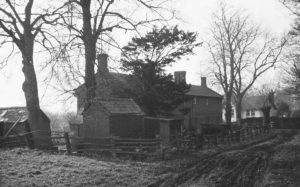
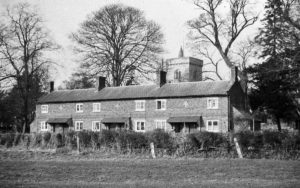
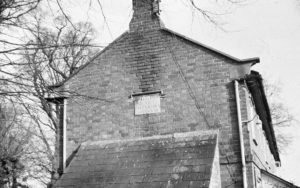
Calverton had 6 Almshouses in Edie’s day.They must have been tiny inside. On the west wall there is a plaque that says” DEO AC PAUPERIBUS MDCCCXXX” meaning “To god and the poor 1830”
Edie remembered that in the end house was a man who used to keep rabbits. All houses shared communal lavatories; one for men and one for women, each situated in a small lean-to extension at opposite ends of the main building. (They have now been converted into 3 homes). Photos source WADAHS
The Causeway
This was the name of the path running roughly from Rectory Farm to Charity Cottages.
The Post Office
This was in those days at No.19 Lower Weald, (Martin & Jenny Luckett’s) and was run by Great Aunt Alice, after the death of her husband, John Cowan, in 1930. She continued as Postmistress until 1962.
The Post Office later carried on business at the Shoulder of Mutton Pub.
The Bakehouse
This was at No. 26 Lower Weald (end cottage on the outside of the sharp corner in Lower Weald). The oven was built into the wall to the left of the fireplace in the front room.
Edie and her father would carry the Sunday joint and Yorkshire pudding down the Leys to get it cooked at the Bakehouse. In summer the range in their house was put out, and they used to cook on an old oil stove.
Edie remembers during one such walk she was sniffing, and her father told her to use her hanky. As she didn’t have one her father lent her his, and she well remembered how it smelt of tobacco.
Gorrick’s (Lion’s Mouth) Spring
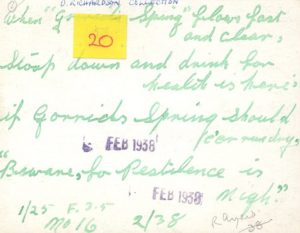
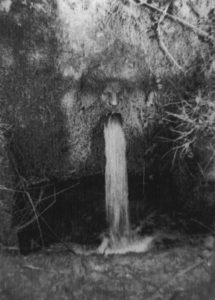
Mr Taylor would collect 2 cans of water from the spring every day. Mrs Taylor missed the spring water after his death, but said her sons couldn’t be bothered to fetch it. Good “watercreeces” were to be found there.
(This photograph was taken in 1938 and kindly lent to us by Wolverton and District Archaeological Society. It shows the original lion’s mouth outlet to the spring from which the more modern name is derived.
Previously it was known as ‘Gorrick’s Spring’. The original sculpted form of the lion’s head was believed to have been made in lead and it was stolen some time later, presumably for its metal content.
On the reverse of the photograph, is noted the famous rhyme concerning the healing powers of the waters.
When Gorrick’s Spring flows fast and clear,
Stoop down and drink for health is here,
If Gorrick’s Spring should e’er run dry,
“Beware for pestilence is nigh”
Manor Farm Cottages
These were known as the Five Hausen, and had corrugated iron fences between them at the back. Two had kitchens built out behind. The windows had shutters. Edie’s family lived in the end cottage, nearest the Church.
Village People
Mrs Lovell – at No. 32, used to sell vinegar at eight pence (3p) for a large bottle and had barrels standing in the pantry. Edie’s mother sent her to buy vinegar, and Edie was so fond of it she would often drink some on the way home. When she got home she would hurriedly leave the bottle on the table in the passage and run like mad, so her mother couldn’t tell her off.
Mrs Tomkins – at No. 30, was a fierce lady, who ran a laundry from the house, and the wing built out the back was probably the wash house. She it was who laundered the church vestments. She was a hard worker, and the washing was taken across the meadow in wicker baskets.
The Habgoods – Dr Habgood and his wife came to live in Calverton Cottage, Lower Weald, at one time. Edie said Mrs Habgood was a lovely lady. Their son John Habgood, went on to become Archbishop of York. Edie remembered him; he used to visit them at No. 56 Calverton Road. When Calverton didn’t have a Rector he would take the services in the church. She said he became religious after writing a book with a friend in Scotland.
Mrs Worley – was the wife of a lawyer and also lived in Calverton Cottage at one time. She was generous but strict. She gave Edie the nickname ‘Dee Dee’ which Edie didn’t like. She was related to Sir Clowdisley Shovell whose ship was wrecked off the coast of Cornwall. On stormy nights, it was said, you could hear the ship’s bell.
Edie said that Mrs Worley ended up moving to ‘Yardley Go By Em’, to a house with a bay window, and a garden down to the canal but when she died she was buried back in Calverton.
Eva Tomkins – was one of Edie’s greatest friends. Her mother died when the children were very young, and Eva looked after her father Reuben, and never married. He was adamant that there was no ‘p’ in their name. Certainly Eva and Edie were not related. Eva lived for many years at No.4 Lower Weald where she eventually died. She is also buried in Calverton.
Mrs Simms – lived at No. 5 Lower Weald and was responsible for the Children’s Corner in the Church. She threw out the old hassocks, and made the curtain that hangs behind the organ. She put carpet on the floor to protect the memorial slabs.
World War II Memories
Mrs Ross-Lowe of Calverton Place ran knitting parties once a week. They would knit socks for the sailors of ships escorting refugee children from London to the USA and Canada. Many years later, at a seaside resort, Edie met some of those sailors, who had now become fishermen, who remembered those socks well; “-never two the same size”
Her husband Eric dug an air-raid shelter in the garden of No. 56. “3 steps down, turn and 3 steps more – all roofed over with earth.”
Bombers targeted Whaddon, Gawcott and Poundon where the Radio Communications were. There were also search-lights at Passenham which would have been very visible from the back of Edie’s house.
Sergeant Rollins, the large local policeman, would arrive on the doorsteps of people living in Stony Stratford, with soldiers stationed at Whaddon for billeting.
Edie and Eric were allocated a 12-year-old refugee girl, but were happy to exchange her with a neighbour’s 4-year-old refugee boy from the Channel Isles, called Rex. He loved dressing up and playing imaginative games, like “let’s pretend to go selling books in Stony” etc. His mother had told him to be very brave, and he was.
He enjoyed his food, and he and Eric would sit down at the table, knife and fork in hand and chant, “why are we waiting?”. Eric continued working at the Wolverton Works by day, but at night “played soldiers”. Edie had her sick parents to look after, also Rex and her niece’s son Brian. Eva Tomkins worked part-time in the Wolverton Works canteen. Clara Clark drove trucks.
Biographical note
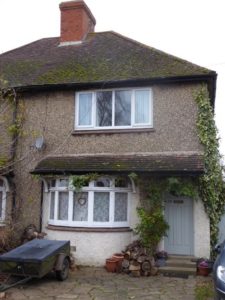
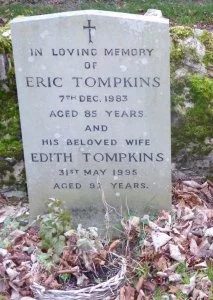
We met up with Edie on a number of occasions in her snug little room at No. 56 Calverton Road. She always kept us amused with her recollections over a cup of tea. People were always popping in to see her and on the occasion of her 92nd birthday the room was full of flowers.
Sadly Edith Tompkins died later that year on 31 May 1995 and is now buried in Calverton churchyard. She is with her husband Eric.